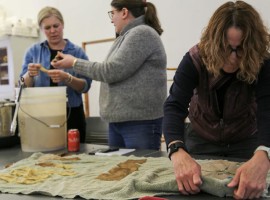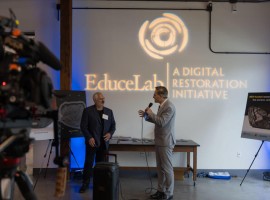Creating Vaccines: How Will They Change the Pandemic?
It has been nearly one year since SARS-COV-2 (COVID-19) changed the world. With millions of people infected and over a quarter-million dead in the United States (U.S.), the novel coronavirus continues its pervasive hold on our health and well-being.
After months of stress, frustration and uncertainty, people are itching to travel and visit loved ones during the height of the holiday season, despite increasing cases of COVID-19. As the virus continues to dominate news coverage, people are clinging to the anticipation of promising vaccine trials from Pfizer and Moderna. How will these vaccines, and potentially others still to come, change the course of the pandemic? Will we be able to return to normal and how long could that take?
“Never before in history has science been the lead story for this long,” said Vincent Venditto, Ph.D., assistant professor in the University of Kentucky College of Pharmacy’s Department of Pharmaceutical Science. “COVID-19 is giving the world a front-row seat to the scientific method and the many challenges that come with creating tools to keep us safe and healthy.”
Venditto’s expertise in vaccine design comes from his training in organic synthesis and vaccine development. Before becoming a professor in the UK College of Pharmacy, Venditto worked on vaccine development as a National Institutes of Health (NIH) postdoctoral fellow at the University of California, San Francisco.
Vaccines: How they work
It is important to know what a vaccine is and how it affects your body. The fundamental purpose of our immune system is to get rid of things that do not belong in our body. It does this by creating inflammation, which causes cells to respond and fight. Think about how your body responds when you become infected with any illness - your temperature elevates, your joints feel sore and tender, you feel fatigued – those are the effects of inflammation. Your immune system is doing what it needs to do to remove the infection from your body.
Vaccines are designed to help our immune system achieve this goal by acting as a pro-inflammatory agent. They help to stimulate your immune response without sending you to the hospital. “The goal of producing a vaccine is to build up our immune response to lessen the severity of symptoms - which keeps people out of the hospital - and to slow the transmission of disease,” Venditto said.
When you get vaccinated, your immune system generates a memory response related to the virus from the vaccine. Later, if you are reinfected with that same virus, you will have immune cells that remember exactly what they need to do to clear the infection.
One important consideration to keep in mind is that while a vaccine is intended to boost immune response, you cannot automatically consider yourself “safe” just because you are vaccinated. Vaccines do not always prevent you from getting infected. Often, they lessen the severity of the infection by helping your immune system respond. You can still get infected and you may still transmit disease. “A COVID-19 vaccine – no matter its effectiveness – will not simply get rid of the disease,” said Brooke Hudspeth, Pharm.D., an associate professor in the UK College of Pharmacy’s Department of Pharmacy Practice and Science. “It will start to cut down on the number of people needing to seek treatment in a hospital, thus minimizing its grip on the health care system, but personal protective measures, like masks and social distancing, will still be necessary to slow the spread.”
Hudspeth is a medication expert with a background in leading pharmacy immunization efforts. She practiced in community pharmacy and worked with Kroger Health before joining UK faculty.
To reach final approval, scientists must prove how effective the vaccine is at producing immune response and how well it does to slow or stop transmission.
Venditto and Hudspeth talk with Behind the Blue to explain the history of vaccines and why they are such an important tool in public health.
Vaccine development: The road to approval
It is not uncommon for a vaccine to take years to meet U.S. Food and Drug Administration (FDA) approval. There are many stages of development, from basic research to clinical trials to FDA review and subsequent post-approval monitoring and research.
“Safety is baked into the process every step of the way,” Venditto said. “If a clinical trial is halted, it does not mean that the vaccine is not safe. In fact, it is just the opposite – it means the researchers in charge are taking the steps to investigate before moving forward.”
Clinical trials happen in three phases. The first phase (Phase I) tests for safety, the second (Phase II) tests for effectiveness and the third phase (Phase III) tests for both safety and effectiveness. By the time a vaccine is in Phase III, there are 10s of thousands of participants in order to test the drug in a large population. If during Phase III, they find that people are generally not getting sicker, the vaccine is working as they anticipated, and researchers will move forward to seek FDA approval.
A common question that arises as the world waits for the first COVID-19 vaccine; how can we know that a COVID-19 vaccine is safe when the process has been so rushed?
Venditto and Hudspeth said federal financial backing plays a key role in expediting the process. They continue the conversation with Behind the Blue on Tuesday, Dec. 8, giving more insight into the past several months of development. They also discuss COVID-19 trials already underway and tell us more about who is participating.
Phase IV – Monitoring
Just because the FDA approves a vaccine initially does not mean that they cannot pull it after it is released.
“The monitoring process, Phase IV, is essential to ensure that the vaccine continues to work the way it is designed, to help keep people safe and create an effective immune response to infection,” Hudspeth said. “Data collection will continue for years after a vaccine is released.”
The FDA notes that like any drug, vaccines have benefits and risks, “even when highly effective, no vaccine is 100 percent effective in preventing disease or 100 percent safe in all individuals.” There are various ways that vaccines are closely monitored, including surveillance systems like Vaccine Adverse Event Reporting System (VAERS) and the Centers for Disease Control and Prevention’s (CDC) Vaccine Safety Datalink.
*****
When a COVID-19 vaccine is eventually released, it will not be available to everyone immediately. There will be an order in which the vaccine will be administered, starting with those populations who are at highest risk, like health care workers and essential workers, and for some in the elderly population.
As discussion of the exact rollout process continues, and even after vaccinations begin, Venditto and Hudspeth stress the importance of continuing to follow the latest guidelines, including wearing a mask, social distancing and hand washing.
“We must continue to protect our health, the health of our families and neighbors by doing the right thing and following the latest guidelines in place,” Hudspeth said.
KODY KISER: Brooke and Vince join us today to give us all the knowledge on vaccines, leaving no stone unturned, correct? We're going to keep you here until we understand all of this. So I hope everybody ordered lunch, at least. So, at least, that's what I'm hoping, that I'll come away with this grand knowledge of all of this.
First things first, let's get the basics out of the way and talk a little bit about our history of vaccines and how they actually work. So, just briefly or however long you want to get into it, how did this idea of vaccines develop in our medical history?
VINCE VENDITTO: It's a great question. It's an interesting story. I should have studied on this a little bit more, but basically way back when in China, actually, they were doing variolation, where they would blow things up your nose to try and activate an immune response. And that's the whole idea behind a vaccination is that you're trying to activate an immune response. You're trying to tell the immune system, like, this doesn't belong in you and you need to attack it. You need to fight it to get rid of it.
So those early stories in China then led eventually to Edward Jenner with the smallpox vaccine where he was using milkmaids and taking scabs from milkmaids and putting them into-- well, I think it was his gardener's child that was the first person that was vaccinated with the smallpox vaccine-- and saw incredible results. And saw that people that were vaccinated had this enhanced immunity to what they were vaccinating against.
So, I mean, that's kind of a brief history of how we got started and how we thought about it, and all of that is really focused on giving the immune system help and basically training the immune system to be able to respond to these things that we don't want to have in our bodies. We don't want to have these viruses and things in our bodies.
And so vaccines are an incredible-- I think it's the second most important public health tool that we use, second only to clean water. Vaccines are such an important aspect of public health, and their development and the technology that we're using currently is just incredible that we can go from this idea of smallpox and taking scabs from infected milkmaids, and now getting to a place where we're only months after a pandemic has been initiated, and now being able to-- almost to approval and ready to roll things out across the country. It's really quite an incredible feat.
KODY KISER: That jump seems amazing to me to go from-- because when I think of from the beginnings of our medical history of the kind of trial and error, and some of the thought and superstition that went into why people got sick. Whether it was bad spirits, or the methods of treatment where you put leeches on people, or we do things with herbs or things.
And some of those things are purely anecdotal. And so to go from those types of things to that type of observational science, I'm always fascinated at that process of being able to, like, observe what is going on with this particular group of people, and maybe if we try to incorporate this into these other people, and then going on to understand at a cellular level and immune response a level of what is going on.
What are the basic mechanisms behind how some of these vaccines work? I've read on especially up with the COVID vaccines that there have been a couple of different approaches. Where they're using different types of cells to incorporate and they're using RNA strands and things like that. Just kind of for me, who, and other people listening who might not understand this, what are the basic mechanisms behind how this type of thing works?
VINCE VENDITTO: Sure. So, I guess before COVID, the way that we would consider delivering vaccines or generating vaccines is to take the actual virus and try to inactivate it, to weaken it. And there are vaccines that are currently in development using this strategy. And so you take a weakened form, it has all of the components there that the immune system needs to respond for us to give that our immune system that help that I discussed.
And everything is there, but it's not fully infectious. So you might get a little sick from this weakened virus, but you're not going to get the full disease that you might see. And so that's one strategy. And all of the components are there, even though it's weakened and it's not necessarily going to replicate, we're not going to have that large outbreak.
But then if you think about taking each of those components, you have proteins, there's lipids, there's genetic material. If you take each of those components and you deliver each of those components individually, you're not going to have the whole collection of the viral components, but you're going to have those specific pieces that we want to generate an immune response against.
And so there are a number of vaccines that take that approach, where we have the proteins on the outside of the coronavirus, we inject those into patients, and now we're inducing an immune response just to those proteins. Not necessarily the whole virus, but our immune response to those proteins are strong enough that we can prevent infection. We can minimize the disease progression.
The mRNA vaccines are now the newest technology. You know, I think that they were developed-- the idea was developed about 10 years ago. And it was originally developed-- well, it was originally developed as an idea, and they thought about using it in Ebola, but by the time they were up and running, they weren't able to actually implement it for Ebola patients in a wide scale like we are doing now.
And the idea behind mRNA vaccines, which Moderna and Pfizer are using, they basically have the genetic material, the RNA strand that they formulate into basically a lipid particle, and then that delivers the genetic material into the cells. So then now your own cells are able to produce those same proteins that I was telling you we were immunizing with before, but now your cells are generating those proteins themselves. And so the idea behind that is if you're able to do it using this mRNA technology, you're now able to access many more protein variance, and you're able to access a broader repertoire of immune responses by using this technology.
And based on the preclinical studies that they did 10 years ago in mice, they saw that they had really great responses. Obviously, it wasn't using coronavirus, it was using some other viruses. But they got really great immune responses and they had really persistent immune responses in the animals that they were studying them in, which made it a really exciting technology to be used. And now we come to this point with coronavirus and it's a perfect opportunity to actually really get these things into patients and into a large population. And thus far, we've seen great success with it.
KODY KISER: How do we generate such a large scale amount of this material, this vaccine material? And if I'm not mistaken, for a long time, I was under the impression that our vaccine, some of them had been developed using like actual, like, chicken eggs. Is that correct and do we still do that for some of our vaccines? And obviously, there's not enough chicken eggs, I wouldn't imagine, to produce enough doses of this. So how do you produce this type of thing on such a mass scale?
VINCE VENDITTO: Brooke, you can jump in any time. I don't want to take all--
BROOKE HUDSPETH: Oh, you're doing great. You're doing great, Vince.
VINCE VENDITTO: So, yeah, with mRNA vaccines, they're produced in a lab. The mRNA sequence-- to be honest, I don't actually know how they're producing the mRNA vaccines. I'm not sure of the engineering behind generating that much. We still do have egg facilities where we have millions of eggs, and Novartis has one of these facilities.
And any of the major vaccine developers. And these egg facilities, they're just shelves and shelves of eggs. And they use the eggs to generate vaccines. With the mRNA vaccines though, they're not using egg facilities. They're using some synthetic method or they're generating them, I don't know. Maybe Brooke is looking this up.
BROOKE HUDSPETH: Yeah. So again, Vince, one of the things that I was going to point out, and I would have to also look into a little bit further as far as the actual mechanisms, and ways, the logistics behind how they are developing these vaccines and those specifics. But one of the questions I know that has come up a lot, and maybe this is where you are heading as well was, how are we able to get such a large quantity in such a short period of time?
And I think if you look at the normal vaccine approval process, you go through all of these steps. These manufacturers go through all of these steps before they start producing the vaccines, but with COVID-19, for example, where we are wanting to have a lot of vaccines produced quickly, and safely, and effectively, the process has shifted a little bit where they, these companies, are going ahead and these manufacturers are going ahead and producing these vaccines before that final approval takes place.
And therefore, they are ready to go as soon as that approval takes place, as opposed to the normal sequence of clearly, a manufacturing company is going to want to go through all of those steps and ensure that it is safe and effective before investing those dollars into development of vaccine. But in the case of COVID-19, they are kind of doing those steps concomitantly, so that there is that supply available in those large quantities, as opposed to the longer process to produce those bigger quantities with other vaccine development.
KODY KISER: And I'm assuming the reason that they can go ahead with this is because the government, the federal government, has stepped in to say, we're going to help fund this. We're going to support this so that you can go ahead and get the wheels turning on the part of it as well.
BROOKE HUDSPETH: Exactly. And so that's a huge factor in allowing that process to go at that quicker speed because there is that support, that government support with funding for these companies to be able to move in that capacity.
VINCE VENDITTO: The other aspect, because the mRNA vaccines are formulated in lipid particles, there's the synthesis of the mRNA, and then you have to combine it with the lipid so that they can actually be delivered. And there's all these microfluidic platforms that are on the market now where you can mix these in a flow chamber. This is maybe too technical, but you basically mix the components together in such a way that allows them to appropriately mix and come together so that you have optimal formulation.
And those strategies are scalable once developed. And used on a small for a mouse study, you can then now scale them up and do millions of liters of these things so that you can actually get them rolled out to a large population. So I guess the short answer is there's a lot of moving parts. Sorry to cut you off.
There's a lot of moving parts going on here. You know, it's from the synthesis of each of the components, the mixing of those components. And then no company would necessarily want to do this without support from the government knowing that their investment at this point is not going to be a waste if their vaccine is a failure, right? Because they're doing all this stuff knowing that they're not going to lose all of their investment in all of these different components, because the government has said we will support whatever you do, right?
KODY KISER: Apart from the accelerated nature of this though, the process is generally the same as it's been for any of our previous vaccines, correct? And, how does that process-- like, what is that like in terms of how it's deemed effective and safe? Who makes the decisions on that as far as safety and the ability to move forward?
VINCE VENDITTO: Brooke, you can--
BROOKE HUDSPETH: Yeah, I'll start this out. So, again, that, like you mentioned, the process typically can take several months for completion. And so if you look at this accelerated process, essentially what they are doing is they are taking those different steps in vaccine development and approval, and overlaying those, and doing some of those steps at the same time.
So for example, typically you have these preclinical trials, and then going into the first phases where you're really looking at safety. And so that piece is still staying pretty firm with the development of the COVID-19 vaccines that are in development right now. But then as you move on to phases two and three that look at continued safety and efficacy now.
And you're seeing some of those done more hand-in-hand, and you're also looking at some larger patient populations, as well as diversity in those patient populations. So that you're able to see the impact or the effects amongst a widely diverse set of patients. Additionally, as you think about safety, which is something that is very important.
So that all of the processes are still in place for looking at safety and that remains maybe even more critical as we're thinking about this vaccine development. But I think one of the biggest pieces is going to be some of that post-vaccine surveillance. So looking at patients for several months after receiving the vaccine or after the vaccine has come to market. Because this is the same no matter what vaccine that we're looking at. There are some very stringent processes in place to ensure that vaccines are safe and effective, as well for patients, but really the safety piece is what remains paramount.
So as we look at administering vaccines, there is a vaccine adverse event reporting system that is in place that providers utilize any time any adverse events are reported from vaccines. And so that will be no different in the case of COVID-19. In fact, there's even an increased emphasis in training of providers to ensure that they are assessing safety even after the vaccines have been approved, and reporting any of those adverse events that patients may be experiencing so that there is this systematic approach to really evaluate safety. And also, as Vince had mentioned, there are many different types of vaccines that are in development, different mechanisms by which those are working. Looking at some new novel approaches for vaccines and the way that they allow for protection.
And so that will be another critical step that is really being emphasized is that there is good tracking in place to ensure the specific vaccines that patients are getting. And I think what we're going to see, maybe even a little bit more so with the COVID-19 vaccine, is more of that systematic approach for reporting and for assessing any types of adverse events, and relating that specifically back to the vaccine type that was administered, and the specific patient population that may be experiencing any of these adverse events.
INTERVIEWER 2: I think safety has really been a key question that everyone has, especially when it relates to COVID-19 and the vaccines that are in development. Vince, we had kind of talked a little bit about this before, but I think when people are seeing the development process play out, they're seeing stopping and starting, and they're hearing about different reactions that people are having, and that they're investigating.
But that doesn't mean that the vaccine isn't safe. That's normal to stop and start in the process. And you even touched on, I think, a trial overseas maybe, where someone got that one reaction that is one out of a thousand chance that you would get. Can you maybe touch a little bit on the stopping and starting process and allowing people to understand that that's normal and it doesn't mean that something's not safe.
VINCE VENDITTO: Yes, sure. So, every clinical trial, this is for vaccines or drugs or anything, they're following Institutional Review Board, so the IRB. And that is basically, here's what we're going to do during this trial. And you set out everything that you're going to do before you start so that you're not biased in how you're interpreting the data. As a part of that, you also have what's called a Data Safety Monitoring Board, a DSMB.
And so they are monitoring all of everything that happens, and they're making the decisions. They're impartial evaluators of your trial. And they're making decisions on whether or not you need to proceed. So when something happens, like one of these adverse reactions happen, the Data Safety Monitoring Board, they look at what happened. They tell you whether or not to stop the trial.
So, for example, AstraZeneca was one of the trials that was stopped early because they had a patient with transverse myelitis. There have been vaccines previously that have induced or presumed to have induced what's called transverse myelitis. It's a disease where you basically have an immune response to your nerves.
And so in a normal flu vaccine, they've reported that maybe one in a million people have this transverse myelitis. And they don't know if it's related to the vaccine or not because they're such a low rate that this is happening. So when we think about 40,000 people in these vaccine trials and one person gets transverse myelitis, they don't know if that's related to the vaccine or not.
And so they stop the vaccine. They do all of the investigation trying to figure out what is the cause. Was it the vaccine that caused transverse myelitis? Or was it just that this person was prone to transverse myelitis, which is possible? And so after doing that investigation then they can restart the trial. So this is normal, this happens all the time.
I mean, it's kind of rare for this not to happen in a clinical trial. You're always wanting the trials to stop and investigate any adverse reaction that's occurring. And that means that the system is working as it should. If we weren't stopping and we were just letting it proceed, so that it was actually going at warp speed or whatever term you want to use, that's where we actually have a problem.
Now, the clinical trials have been accelerated, but they're still going through all the same safety mechanisms and safety regulations that are required for any drug or any vaccine that's on the market. So and those vaccines, all of the adverse reactions that we've seen so far with the vaccine trials, to my knowledge, have not been linked to the vaccine, but have been associated with a different cause.
KODY KISER: I think that's been maybe the hurdle that a lot of people have had problems with is this development of a vaccine for COVID-19 has seemed so rushed or has seemed like it's, like, how did we make this so quickly. Especially when it's framed in the, I guess, the media narrative of, well, the quickest we've ever done this before was four years for, I guess, for mumps.
And so when it's framed in that context and then the conversations all center around that of, like, it took us that long before, it tends to create this narrative that this is unnatural or this is something that is going to be problematic because we've-- but what we're saying here is that a couple of factors are at play. One, the groundwork for this was laid years ago because of the work that we were doing with Ebola.
So a lot of those fundamental mechanics seemed to be in place there. And then also as you've both kind of described, the checks and balances and the things that cause these to stop and start are all in place and have all seemed to have been working as the AstraZeneca model has shown us that some of these have stopped.
VINCE VENDITTO: Exactly. And the other thing that I think is important is that these companies are being more transparent about their data now than they've ever really been before with other trials, and they're releasing the number of patients that are in these trials, the diversity of the patients enrolled in, and the subjects enrolled in the trials, and when they're stopping and starting.
Now, there are other countries that have vaccines in the works and they're not releasing any data, and they've even improved some of these vaccines. So we don't really know anything about them. And that's where I would be a little bit more concerned. But there's enough people that are able to put their eyes on this data to say that, yeah, it seems like things are moving appropriately and safely.





